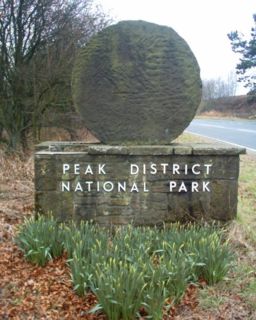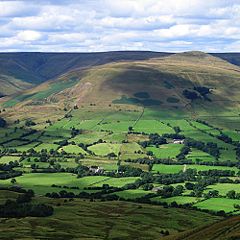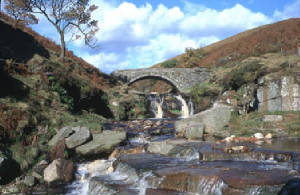|

Britain's first national
park, established in 1951, is visited by people from all over the world. They come to find peace, tranquility and adventure,
experiencing some of England’s finest climbing, caving, walking and cycling.
Right
at the heart of England, The Peak District’s very special qualities are well known to the people who live in the towns
and cities that surround the National Park but for visitors from further away, whether from Britain or abroad, the magic of
the Peak District is just waiting to be discovered. The Peak District is an area of great natural beauty with rugged, peat-covered moorlands
and magnificent limestone dales, plus picturesque villages and some interesting towns. An area of great diversity, it
is conventionally split into the northern Dark Peak, where
most of the moorland is found and whose geology is gritstone,
and the southern White Peak, where most of the population lives
and where the geology is mainly limestone-based.
The
Peak District is an upland region of Midland and Northern England which encompasses a large part of Derbyshire plus parts
of Staffordshire Moorlands, Cheshire and Yorkshire. Proximity to the major conurbations of the North East Midlands,
Yorkshire, Lancashire and Greater Manchester, coupled with easy access by road and rail, have all contributed to its popularity.
With an estimated 22 million visitors per year, the Peak District is thought to be the second most visited national park in
the world, after the Mount Fuji National Park in
Japan.

The Peak District has numerous interesting and exciting tourist attractions. Probably
the chief among these is Chatsworth House - a magnificent house set in a landscaped park which is the home of the
Dukes of Devonshire - major landowners in the area. This is followed by Haddon Hall outside Bakewell - the
home of the Manners family, who are the Dukes of Rutland. Haddon Hall is notable because it was left untouched for many
centuries before being restored in the early 20th century, so it now shows us just what a medieval manor house looked like.
On the western fringe of the Peak District there is Lyme
Hall - a National Trust property which was once the
home of the Legh family. This was used in the 1990s BBC version of 'Pride and Prejudice' as the home of Mr D'Arcy.
To the east, just outside the National Park area, lies Hardwick
Hall, another National Trust Property which was built
by Bess of Hardwick - one of the most powerful women of the Elizabethan era.

If you are interested in history then the Peak District has many places
of interest. These range from the Stone Circles at Arbor
Low and Stanton Moor, through the hill fort
at Mam Tor and the Norman Castle (Peveril Castle) at nearby Castleton through to Richard Arkwright's original cotton mill (the
world's first) at Cromford. In addition, there
are numerous fine churches, such as Tideswell Church, known locally as 'The Cathedral of the Peak.
The Peak District is a fine place for outdoor activities such as walking, rock-climbing,
caving and hang-gliding and cycling, and each week and especially at weekends; many thousands of people come
here to enjoy these activities.

There are numerous interesting towns to explore. Buxton is the one
with the longest history, having been founded by the Romans, who exploited the warm spring water to build thermal baths, for
which the town became very popular in the 18th and 19th centuries. As a result it has some magnificent buildings, notably
the Georgian Crescent and the Opera House. It now has a thriving music and arts festival each summer.
Bakewell
was founded in Saxon Times and is the home of the Peak District National Park Authority and is a busy market town notable
for its livestock market. To the south lies Ashbourne, another market town founded by the Saxons, now the southern gateway
to the Peak District.
In the north, Glossop is a former mill town which is the gateway to the northern part of the
Peak, controlling the routes across the Pennies. More mill towns lie around the western and south-western fringes of
the Peak - Macclesfield and Leek, which were both once centers for the manufacture of silk.
Matlock's development
is surprisingly recent as access to it from the south was difficult until the 19th century, but after this it developed rapidly
as a spa, and it is now the county town of Derbyshire. Matlock Bath has numerous tourist sites and is a popular destination
for day-trippers.
Not far from Matlock, Wirksworth is another ancient Saxon market town which was once the centre
of the local lead mining industry, which has left it with narrow winding streets and rows of quaint miners' cottages.
|